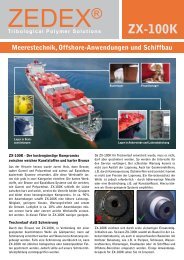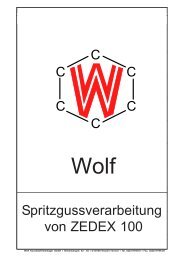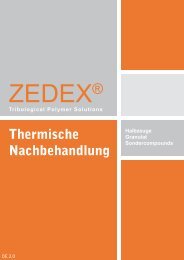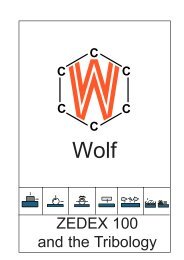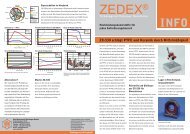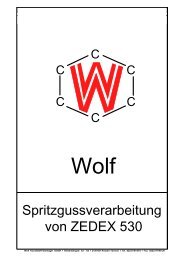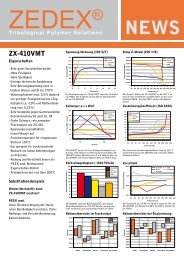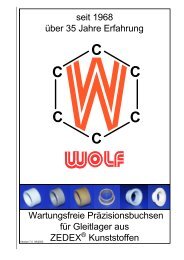Sterilization of the plastics ZEDEX® - Wolf Kunststoff-Gleitlager GmbH
Sterilization of the plastics ZEDEX® - Wolf Kunststoff-Gleitlager GmbH
Sterilization of the plastics ZEDEX® - Wolf Kunststoff-Gleitlager GmbH
Create successful ePaper yourself
Turn your PDF publications into a flip-book with our unique Google optimized e-Paper software.
Security<br />
The quantity <strong>of</strong> sterilization cycles<br />
that a material is able to stand,<br />
depends on several factors as tempe-<br />
Improvements<br />
Thanks to our extensive testing facilities,<br />
we <strong>of</strong>fer you <strong>the</strong> opportunity<br />
to change <strong>the</strong> components´ proper-<br />
ZEDEX ®<br />
Tr i b o l o g i c a l P o l y m e r S o l u t i o n s<br />
rature, chemical agents, sterilization<br />
ties considering your specific appli-<br />
equipment and processing parameters.<br />
Therefore, <strong>the</strong> materials should<br />
be tested following specific operatio-<br />
cation. If a standard <strong>plastics</strong> do not<br />
have <strong>the</strong> required properties, we can<br />
produce special compounds accor-<br />
I NFO<br />
nal and sterilization terms.<br />
ding to <strong>the</strong> expected properties.<br />
Water vapour 140°C<br />
3<br />
X<br />
3<br />
1<br />
2<br />
1<br />
1<br />
1<br />
2<br />
2<br />
Hydrogen peroxide<br />
2<br />
X<br />
2<br />
1<br />
1<br />
1<br />
1<br />
1<br />
2<br />
2<br />
Ozone<br />
1<br />
X<br />
1<br />
1<br />
1<br />
1<br />
1<br />
1<br />
1<br />
1<br />
Paracetic acid<br />
2<br />
X<br />
2<br />
1<br />
1<br />
1<br />
1<br />
1<br />
2<br />
2<br />
Formaldehyde<br />
2<br />
X<br />
2<br />
1<br />
2<br />
1<br />
1<br />
1<br />
3<br />
3<br />
1 – Marginally<br />
influenced by<br />
2 – Optical variations<br />
3 – Properties variations<br />
X – Not suitable<br />
ZX-100K<br />
ZX-100EL55/63<br />
ZX-100MT<br />
ZX-324<br />
ZX-324V1T<br />
ZX-324V2T<br />
ZX-324V11T<br />
ZX-324VMT<br />
ZX-410<br />
ZX-410V7T<br />
Support<br />
The instructions and information in<br />
this document permit <strong>the</strong> comparison<br />
<strong>of</strong> our materials and thus to<br />
choose <strong>the</strong> appropriated one. On request,<br />
we will give you more specific<br />
information, or we will support you<br />
in your material selection.<br />
Reference: [1] Wikipedia<br />
<strong>Sterilization</strong> <strong>of</strong> <strong>the</strong> <strong>plastics</strong> ZEDEX ®<br />
Introduction<br />
The word sterilization describes <strong>the</strong><br />
procedure to eliminate <strong>the</strong> microorganisms<br />
from materials and items.<br />
After this procedure, <strong>the</strong> materials<br />
and items are called with <strong>the</strong> term<br />
“sterile”.<br />
Through <strong>the</strong> sterilization <strong>of</strong> <strong>the</strong><br />
items, would be <strong>the</strong>oretically destroyed<br />
all <strong>the</strong> microorganisms that<br />
belong to or hang on <strong>the</strong> items,<br />
ximum one in a million.<br />
Looking at <strong>the</strong> technical definition<br />
<strong>of</strong> disinfection, it can be noticed that<br />
generally <strong>the</strong> sterilization has got a<br />
bigger probability (in power <strong>of</strong> 10)<br />
<strong>of</strong> a full sterilization.<br />
The sterilization is obtainable<br />
through physical (<strong>the</strong>rmal, radiation)<br />
or chemical procedures.<br />
Chemical <strong>Sterilization</strong><br />
A critical parameter in all <strong>the</strong> liquid<br />
chemical sterilization processes, is<br />
<strong>the</strong> temperature <strong>of</strong> <strong>the</strong> sterilizing<br />
solution. To remove <strong>the</strong> chemicals<br />
from <strong>the</strong> sterilized object, this one is<br />
typically washed with sterile water.<br />
Dry sterilization process<br />
“Dry sterilization process” refers to<br />
a not clearly defined group <strong>of</strong> sterilization<br />
procedures. The microorga-<br />
1<br />
2<br />
1<br />
1<br />
1<br />
ZX-530<br />
<strong>the</strong>refore killing <strong>the</strong> spore forms,<br />
The term “chemical sterilizati-<br />
nisms killing is done with gas on <strong>the</strong><br />
1<br />
2<br />
1<br />
1<br />
1<br />
ZX-530CD3<br />
viruses, prions (proteinaceous infec-<br />
on” refers to a sterilization made<br />
dry item to be sterilized. Gas ste-<br />
1<br />
2<br />
1<br />
1<br />
1<br />
ZX-530EL3<br />
tious particle), plasmids and o<strong>the</strong>r<br />
through specifics chemical substan-<br />
rilization is performed for example<br />
1<br />
1<br />
1<br />
2<br />
2<br />
2<br />
1<br />
1<br />
3<br />
3<br />
1<br />
1<br />
1<br />
1<br />
1<br />
1<br />
1<br />
1<br />
1<br />
1<br />
1<br />
1<br />
1<br />
1<br />
1<br />
ZX-530KF15<br />
ZX-550<br />
ZX-550PV<br />
ZX-750V5T<br />
ZX-750V5KF<br />
Table 2: relative resistance to <strong>the</strong> chemical sterilizations<br />
DNA-fragments.<br />
In <strong>the</strong> praxis, a full sterilization is<br />
not achievable with a reliability <strong>of</strong><br />
100 %. Therefore we can talk about<br />
a reduction <strong>of</strong> <strong>the</strong> microorganisms<br />
number <strong>of</strong> a specific factor (in powers<br />
<strong>of</strong> 10), depending on <strong>the</strong> applica-<br />
ces, as formaldehyde or peracetic<br />
acid. The chemical sterilization is<br />
normally used for <strong>the</strong>rmolabile materials.<br />
With <strong>the</strong>rmostable materials,<br />
it is always preferable a steam sterilization<br />
to a chemical sterilization.<br />
Liquid chemical sterilization<br />
with formaldehyde, ethylene oxide,<br />
ozone or hydrogen peroxide.<br />
This procedure occurs frequently in<br />
<strong>the</strong> cold antiseptic filling <strong>of</strong> foods,<br />
especially in beverages. Before<br />
filling <strong>the</strong> to be sterilized objects,<br />
mostly plastic bottles made <strong>of</strong> PET<br />
tion required, or about a possibility<br />
The destruction <strong>of</strong> microorganisms<br />
or HDPE, <strong>the</strong>se ones are sterilized<br />
<strong>of</strong> full sterilization. For example, it<br />
is done by <strong>the</strong> application <strong>of</strong> che-<br />
first with chemical agents, mostly<br />
is possible to require, that <strong>the</strong> resi-<br />
micals, some <strong>of</strong> <strong>the</strong>m in a liquid<br />
with peracetic acid products, <strong>the</strong>n<br />
dual content <strong>of</strong> <strong>the</strong> microorganisms<br />
form, on <strong>the</strong> items to be sterilized.<br />
washed (liquid chemical sterilization<br />
<strong>Wolf</strong> Kunstst<strong>of</strong>f-<strong>Gleitlager</strong> <strong>GmbH</strong><br />
Heisenbergstr. 63-65<br />
D-50169 Kerpen-Türnich<br />
Telefon: +49 2237 9749-0<br />
Telefax: +49 2237 9749-20<br />
Email: info@zedex.de<br />
www.zedex.de<br />
– Plastic wear resistance parts<br />
– Plastic machine elements<br />
– Customer service<br />
– Materials development<br />
– Components design<br />
– Prototypes production<br />
– Large-scale manufacturing<br />
<strong>of</strong> a sterilized item is maximum 10 −6<br />
c.f.u. (colony forming units). That<br />
means, that <strong>the</strong> possibility <strong>of</strong> finding<br />
a microorganism in <strong>the</strong> item, is ma-<br />
For example, <strong>the</strong> sterilization in <strong>the</strong><br />
beverage technology, is made with<br />
hydrogen peroxide, dissolved ozone<br />
or peracetic acid.<br />
process) and as final treatment, for<br />
a fur<strong>the</strong>r killing <strong>of</strong> microorganisms,<br />
additional gases are used, preferably<br />
hydrogen peroxide in gaseous form.
Moist heat sterilization<br />
metals, porcelain are made with<br />
As a result <strong>of</strong> <strong>the</strong>se reactions, <strong>the</strong><br />
The absorbed dose rate indicates<br />
limit value, an elongation at break<br />
gamma rays very resistant. A gam-<br />
The moist heat sterilization (heating<br />
one <strong>of</strong> <strong>the</strong> following procedures:<br />
following changes can also occur<br />
how fast <strong>the</strong> energy is absorbed<br />
decrement <strong>of</strong> –25 % from <strong>the</strong> initial<br />
ma-ray absorbed dose <strong>of</strong> 10 000<br />
in an autoclave) is <strong>the</strong> standard pro-<br />
180 °C for at least 30 min.<br />
weeks after <strong>the</strong> radiation procedure:<br />
[Gy / s].<br />
value is used. Looking at this gra-<br />
kGy causes nearly no damage.<br />
cedure. The air inside <strong>the</strong> autoclave<br />
is completely replaced by water<br />
steam. The real time and <strong>the</strong> temperature<br />
necessary for a sterilization<br />
process depends on <strong>the</strong> autoclave<br />
170 °C for at least 60 min.<br />
160 °C for at least 120 min.<br />
Radiation sterilization<br />
<strong>Sterilization</strong> by ionizing radiation<br />
– discoloration<br />
– gas separation<br />
– odour formation<br />
– cross linking<br />
– embrittlement<br />
Between a sterilization done ei<strong>the</strong>r<br />
by electron beam, or X-ray or<br />
gamma-ray, <strong>the</strong>re are no direct differences,<br />
concerning <strong>the</strong>ir influence<br />
on <strong>the</strong> plastic properties variations,<br />
phic is observable, that <strong>the</strong>rmosetting<br />
plastic are more resistant than<br />
<strong>the</strong> <strong>the</strong>rmoplastic, and aromatic<br />
polymers are more resistant than<br />
<strong>the</strong> aliphatic ones. Plastics with low<br />
Rating <strong>of</strong> ZEDEX ® polymers<br />
against <strong>the</strong> chemicals used in<br />
<strong>the</strong> sterilization<br />
The family ZX-530 has got <strong>the</strong> high-<br />
type and on <strong>the</strong> pathogens agents´<br />
could be done with UV-rays, X-rays,<br />
– streng<strong>the</strong>ning<br />
<strong>of</strong> course when <strong>the</strong>se procedures<br />
density have got a higher resistance.<br />
est chemical resistance <strong>of</strong> all <strong>the</strong><br />
resistance.<br />
The item is heated 20 minutes at<br />
121 °C with a water steam’s pressu-<br />
gamma rays (principally with <strong>the</strong><br />
radioactive isotope Cobalt-60) or<br />
electron bombardment (electron<br />
– s<strong>of</strong>tening<br />
– chemical decomposition<br />
– molar mass variation<br />
have got <strong>the</strong> same absorbed dose<br />
and dose absorbed rate.<br />
Anyway, <strong>the</strong>re is an indirect diffe-<br />
Rating <strong>of</strong> ZEDEX ® polymers<br />
resistance against radiations<br />
<strong>ZEDEX®</strong> <strong>plastics</strong>.<br />
PEEK is also inferior to ZX-530.<br />
When <strong>the</strong> ZX-530 comes in contact<br />
re <strong>of</strong> 2 bar, or 5 minutes at 134 °C<br />
beam sterilization, beam energy<br />
– improvement or deterioration <strong>of</strong><br />
rence between a sterilization made<br />
ZX-100K is relatively resistant to<br />
with few chemicals a colour change<br />
with a pressure <strong>of</strong> 3 bar. To elimina-<br />
from 3 to 12 MeV, typical absorbed<br />
<strong>the</strong> mechanical and chemical pro-<br />
with gamma irradiation and one<br />
high-energy radiation. A first strong<br />
occurs, which, however, do not affect<br />
te <strong>the</strong> prions, a temperature <strong>of</strong> 134<br />
dose <strong>of</strong> 25 kGy). In <strong>the</strong> industrial<br />
perties<br />
made with an electron beam. In<br />
degradation occurs with an absorbed<br />
<strong>the</strong> properties.<br />
°C, with 3bar pressure and a time <strong>of</strong><br />
sterilization process (as <strong>the</strong> medical<br />
– change in <strong>the</strong> melting and glass<br />
fact in both procedures an oxidative<br />
dose <strong>of</strong> 1000 kGy (10 kGy / h; 1<br />
The family ZX-324 is chemicals<br />
18 minutes are required.<br />
disposables) gamma irradiations or<br />
transition temperature<br />
degradation takes place.<br />
meV gamma ray, source: Cobalt-60).<br />
resistant to all <strong>the</strong> chemicals used<br />
Dry heat sterilization<br />
– The annealing <strong>of</strong> metal objects<br />
electron beams are used in largescale.[1]<br />
– toxicological changes.<br />
High energy radiation<br />
However with <strong>the</strong> same absorbed<br />
dose and dose absorbed rate, this<br />
degradation is with an electron<br />
ZX-410 has got a high resistance to<br />
gamma-rays and beta-rays radiations.<br />
After a radiation exposure <strong>of</strong><br />
during a sterilization and an antiseptic<br />
process.<br />
The ZX-410 and ZX-100, after seve-<br />
through a temperature <strong>of</strong> about<br />
Plastic reaction<br />
The radiation absorbed dose is defi-<br />
beam many times higher than with a<br />
15000 kGy (2 MeV electron beam;<br />
ral sterilization procedures, have got<br />
500 °C, is commonly used in micro-<br />
The energy radiation involve,<br />
ned as <strong>the</strong> amount <strong>of</strong> energy absor-<br />
gamma irradiation.<br />
5 kGy / s), ZX-410 has still got 90<br />
a properties variation.<br />
biological laboratories.<br />
depending on <strong>the</strong> plastic type, <strong>the</strong><br />
bed per unit mass.<br />
% <strong>of</strong> its tensile strength.<br />
– The flame treatment: <strong>the</strong> item is<br />
following reactions:<br />
SI unit is [J / kg] or [Gy]; <strong>the</strong> old<br />
Relative resistance against high<br />
ZX-324V1T is to alpha, beta and<br />
subjected for few seconds to a<br />
– chain scission<br />
unit was [Rad], abbreviated “rd”.<br />
energy radiation<br />
flame treatment.<br />
– chain branching<br />
The conversion is <strong>the</strong> following: 1 J /<br />
Figure 1 shows <strong>the</strong> pure radiation<br />
– The dry heat sterilization <strong>of</strong> glass,<br />
– cross linking<br />
kg = 1 Gy = 100 rad.<br />
resistance <strong>of</strong> <strong>plastics</strong>. As property<br />
1 – Not affected by<br />
2 – Optical variations<br />
3 – Properties variations<br />
X – Not suitable<br />
Moist heat<br />
sterilization<br />
Dry heat sterilization<br />
at 160°C<br />
Gamma rays radiation<br />
sterilization<br />
Liquid chemical sterilization<br />
ZX-100K<br />
ZX-100EL63<br />
ZX-100MT<br />
ZX-324<br />
ZX-324V1T<br />
ZX-324V2T<br />
ZX-324V11T<br />
ZX-324VMT<br />
bei 121°C 2 2 2 1 1 1 1 2 1 2 2 2 2 1 1 1 2 2<br />
bei 134°C 3 3 3 1 1 1 1 2 2 2 2 2 2 3 1 1 2 2<br />
bei 143°C 3 X 3 1 1 1 1 2 2 2 3 3 2 3 1 1 X X<br />
ZX-410<br />
X X X 1 1 1 1 1 1 1 2 2 2 2 1 1 1 1<br />
3 3 3 1 1 2 1 2 2 2 3 3 3 3 X X 2 2<br />
2 X 2 1 2 1 1 1 2 3 1 1 1 1 1 1 1 1<br />
UV rays sterilization 2 X 2 2 2 2 2 1 1 1 2 2 2 2 2 2 X X<br />
ZX-410V7T<br />
ZX-530<br />
ZX-530CD3<br />
ZX-530EL3<br />
ZX-530KF15<br />
ZX-550<br />
ZX-550PV<br />
ZX-750V5T<br />
ZX-750V5KF<br />
PF<br />
MF<br />
PI<br />
EP unsaturated<br />
PEEK amorphous<br />
PEI<br />
PAI<br />
PEEK semi-crystalline<br />
PUR <strong>the</strong>rmoset<br />
PPS<br />
PVDF<br />
PELD<br />
PET<br />
PES<br />
PC<br />
PVC<br />
ABS<br />
PSU<br />
PBT<br />
UHMWPE<br />
PA 11<br />
HD PE<br />
PA 6; PA 12<br />
PMMA<br />
POM C<br />
PTFE<br />
PP<br />
Spalte 1<br />
Spalte 1<br />
ZX-324V1T<br />
ZX-324<br />
ZX-410<br />
ZX-324V2T<br />
ZX-324VMT<br />
ZX-324V11T<br />
ZX-750V5T<br />
ZX-750V5KF<br />
ZX-410V7T<br />
ZX-100K<br />
ZX-100MT<br />
ZX-530KF15<br />
ZX-530<br />
ZX-530EL3<br />
ZX-100EL55/63<br />
ZX-530CD3<br />
ZX-550<br />
ZX-550PV<br />
<strong>Sterilization</strong> dose (lethal for microorganisms)<br />
Dry sterilization<br />
(Ethylene oxide)<br />
1 X 1 1 1 1 1 1 1 1 1 1 1 1 1 1 1 1<br />
10 100 1.000 10.000<br />
Threshold limit dose, down to an elongation at break decrement <strong>of</strong> –25% [kGy]<br />
10 100 1.000 10.000<br />
Threshold limit dose, down to an elongation at break decrement <strong>of</strong> -25% [kGy]<br />
Table 1: kind <strong>of</strong> sterilizations and influence <strong>of</strong> <strong>the</strong> sterilization procedures on <strong>the</strong> plastic (relative comparison)<br />
Figure 1: relative resistance <strong>of</strong> <strong>the</strong> standard <strong>plastics</strong><br />
Figure 2: relative resistance <strong>of</strong> <strong>the</strong> ZEDEX ® plastic



